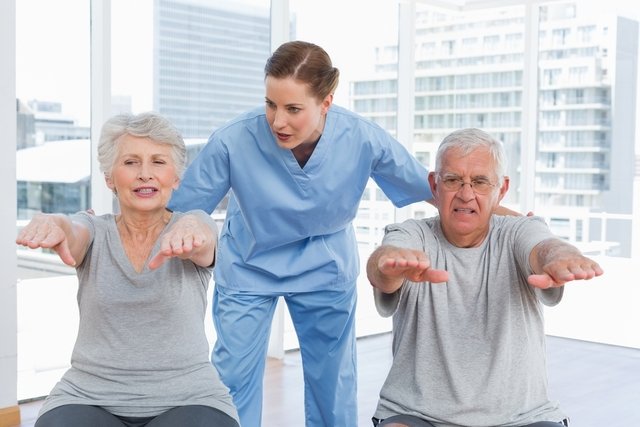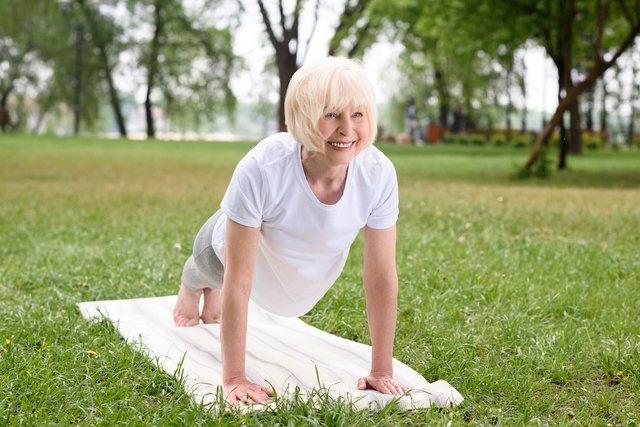Physiotherapy for Alzheimer’s should be carried out 2-3 times a week in patients who are at an early stage of the disease and who present symptoms such as difficulty walking or balancing, for example, helping to delay the progression of the disease and maintaining the patient autonomy for a longer period of time. However, in the advanced stages of being bedridden, it is important to do physical therapy daily to prevent muscle atrophy and maintain joint range.
Alzheimer’s disease is a progressive degenerative disease that is characterized by loss of memory and cognition, which makes the most basic daily tasks of daily life difficult/impossible, such as eating and cleaning. This disease mainly affects the elderly, and although rare, it can also develop early between the ages of 30-50. Treatment consists of medicines, adequate nutrition and physiotherapy exercises, where the objective is to delay the progression of the disease, improving quality of life.

Benefits of physical therapy for Alzheimer’s
Physiotherapy treatment for elderly people with Alzheimer’s aims to:
- Help the individual move more freelymaintaining some autonomy and mobility to move in bed, sit or walk, for example;
- Prevent muscles from becoming trapped and atrophied, which cause pain and make tasks such as daily hygiene difficult;
- Allow good range of jointsto carry out day-to-day tasks;
- Avoid falls that can lead to bone fractures, who may require surgical treatment;
- Prevent muscle pain, bones and tendons, which cause discomfort and discomfort.
In this way, physiotherapy allows the individual to maintain some autonomy, being able to carry out their day-to-day tasks alone or with as little help as possible. Furthermore, the ability to move and mobilize alone helps to delay common problems with the disease, such as constipation, the development of respiratory infections or bedsores.
Exercises for Early Alzheimer’s

In general, when a person discovers that they have Alzheimer’s they should perform aerobic, strength, balance and coordination exercises, which is why the most recent cases of Alzheimer’s can benefit from group exercises, with weights and balls, walking, running , swimming, water aerobics and Pilates.
Other exercises also recommended are progressive walking, keeping a conversation, and cycling for at least 30 minutes daily, because this type of activity improves motor and respiratory function, also provides cognitive gains, improving memory, reducing cerebral hippocampal atrophy, being Therefore, a great complement to treatment and thus reduce the progression of Alzheimer’s. Muscle strengthening exercises, such as weight training, are also welcome.
Exercises for intermediate Alzheimer’s

The exercises that can be performed at home must be easy to understand, so that the patient can understand, and must be similar to everyday activities, in order to increase intellectual and motor activity at the same time. These should be performed in brief periods of time, several times a day, to avoid exhaustion. Some examples are:
- Walk around the yard or dance;
- Place a plastic ball on top of your head and try to balance yourself;
- Practice brushing your teeth and combing your own and your caregiver’s hair;
- Fasten the buttons on your blouse;
- Stand on one foot;
- Walking sideways and also in the form of a circuit;
- Arm raises using 2-3 kg weights;
- Squats against the wall;
- Walk placing one foot in front of the other;
- Twerking using a hula hoop;
- Abdominal plank with knee support on the floor;
- Ponte abdominal.
The exercises can be performed by the physiotherapist and the caregiver, and can be modified, according to need and to provide greater variation in training, which increases interest in the activity.
Exercises for Advanced Alzheimer’s
In advanced Alzheimer’s, the person may find themselves bedridden or have difficulty balancing even when sitting. In this case, physiotherapy should be performed every day with a physiotherapist, to prevent the patient from losing muscle mass and having atrophied muscles and joints, which cause pain and discomfort, and also make hygiene difficult.
The physiotherapist should recommend simple strengthening and stretching exercises, asking the patient for collaboration whenever possible. Other techniques such as mobilization and the use of resources such as TENS, ultrasound, infrared and other thermotherapeutic resources can also be used.
Bibliography
- ZAIONS, Janaína Dalla Costa; PAVAN, Fábio José; WISNIEWSKI, Miriam Salete. The influence of physiotherapy on preserving memory and functional capacity in elderly people with Alzheimer’s disease: case report . Perspective. Vol.36. n.133; 151-162, 2012
- LOPES, M. N. S. S.; PASSERINI, C. G.; TRAVENSOLO, C. F.. Efficacy of a physiotherapeutic protocol for balance in institutionalized elderly people. Semina: Biological and Health Sciences. Vol.31. n.2; 143-152, 2010
- PANZA, Gregory A. et al. Can Exercise Improve Cognitive Symptoms of Alzheimer’s Disease?. Journal of the American Geriatrics Society (JAGS). Vol.66. n.3; 487-495, 2018
- YU, Fang et al. Effects of aerobic exercise on cognition and hippocampal volume in Alzheimer’s disease: study protocol of a randomized controlled trial (The FIT-AD trial). Trials Journal . 15; 394, 2014

Sign up for our newsletter and stay up to date with exclusive news
that can transform your routine!
Warning: Undefined array key "title" in /home/storelat/public_html/wp-content/plugins/link-whisper-premium/templates/frontend/related-posts.php on line 12
Warning: Undefined array key "title_tag" in /home/storelat/public_html/wp-content/plugins/link-whisper-premium/templates/frontend/related-posts.php on line 13



